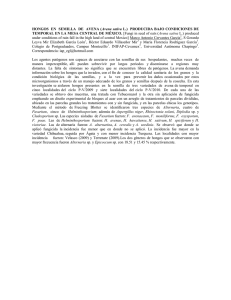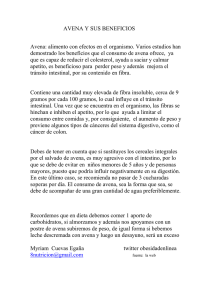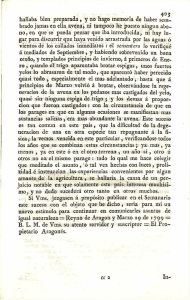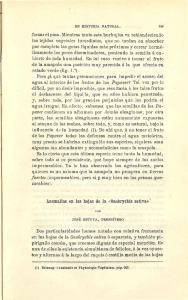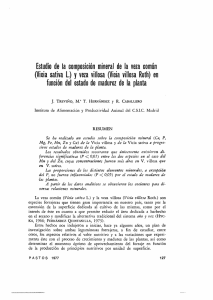comepetencia entre tres cultivares de trigo y avena sativa
Anuncio
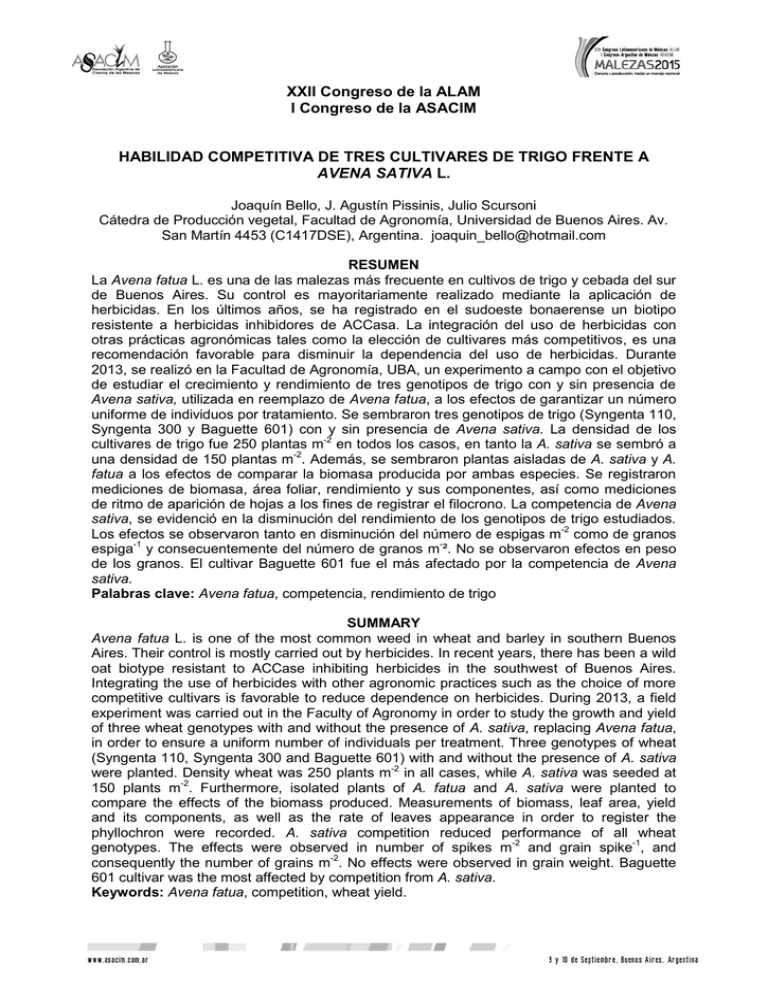
XXII Congreso de la ALAM I Congreso de la ASACIM HABILIDAD COMPETITIVA DE TRES CULTIVARES DE TRIGO FRENTE A AVENA SATIVA L. Joaquín Bello, J. Agustín Pissinis, Julio Scursoni Cátedra de Producción vegetal, Facultad de Agronomía, Universidad de Buenos Aires. Av. San Martín 4453 (C1417DSE), Argentina. joaquin_bello@hotmail.com RESUMEN La Avena fatua L. es una de las malezas más frecuente en cultivos de trigo y cebada del sur de Buenos Aires. Su control es mayoritariamente realizado mediante la aplicación de herbicidas. En los últimos años, se ha registrado en el sudoeste bonaerense un biotipo resistente a herbicidas inhibidores de ACCasa. La integración del uso de herbicidas con otras prácticas agronómicas tales como la elección de cultivares más competitivos, es una recomendación favorable para disminuir la dependencia del uso de herbicidas. Durante 2013, se realizó en la Facultad de Agronomía, UBA, un experimento a campo con el objetivo de estudiar el crecimiento y rendimiento de tres genotipos de trigo con y sin presencia de Avena sativa, utilizada en reemplazo de Avena fatua, a los efectos de garantizar un número uniforme de individuos por tratamiento. Se sembraron tres genotipos de trigo (Syngenta 110, Syngenta 300 y Baguette 601) con y sin presencia de Avena sativa. La densidad de los cultivares de trigo fue 250 plantas m-2 en todos los casos, en tanto la A. sativa se sembró a una densidad de 150 plantas m-2. Además, se sembraron plantas aisladas de A. sativa y A. fatua a los efectos de comparar la biomasa producida por ambas especies. Se registraron mediciones de biomasa, área foliar, rendimiento y sus componentes, así como mediciones de ritmo de aparición de hojas a los fines de registrar el filocrono. La competencia de Avena sativa, se evidenció en la disminución del rendimiento de los genotipos de trigo estudiados. Los efectos se observaron tanto en disminución del número de espigas m-2 como de granos espiga-1 y consecuentemente del número de granos m-². No se observaron efectos en peso de los granos. El cultivar Baguette 601 fue el más afectado por la competencia de Avena sativa. Palabras clave: Avena fatua, competencia, rendimiento de trigo SUMMARY Avena fatua L. is one of the most common weed in wheat and barley in southern Buenos Aires. Their control is mostly carried out by herbicides. In recent years, there has been a wild oat biotype resistant to ACCase inhibiting herbicides in the southwest of Buenos Aires. Integrating the use of herbicides with other agronomic practices such as the choice of more competitive cultivars is favorable to reduce dependence on herbicides. During 2013, a field experiment was carried out in the Faculty of Agronomy in order to study the growth and yield of three wheat genotypes with and without the presence of A. sativa, replacing Avena fatua, in order to ensure a uniform number of individuals per treatment. Three genotypes of wheat (Syngenta 110, Syngenta 300 and Baguette 601) with and without the presence of A. sativa were planted. Density wheat was 250 plants m-2 in all cases, while A. sativa was seeded at 150 plants m-2. Furthermore, isolated plants of A. fatua and A. sativa were planted to compare the effects of the biomass produced. Measurements of biomass, leaf area, yield and its components, as well as the rate of leaves appearance in order to register the phyllochron were recorded. A. sativa competition reduced performance of all wheat genotypes. The effects were observed in number of spikes m-2 and grain spike-1, and consequently the number of grains m-2. No effects were observed in grain weight. Baguette 601 cultivar was the most affected by competition from A. sativa. Keywords: Avena fatua, competition, wheat yield.
